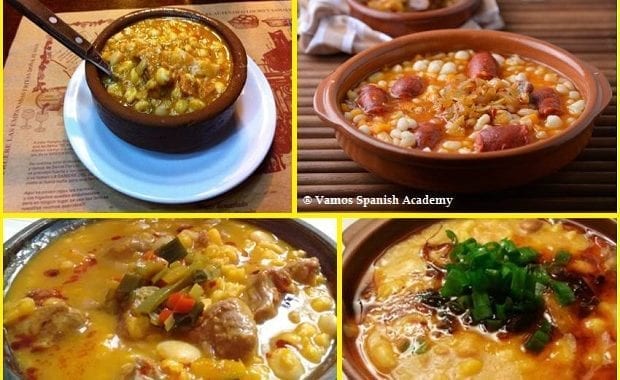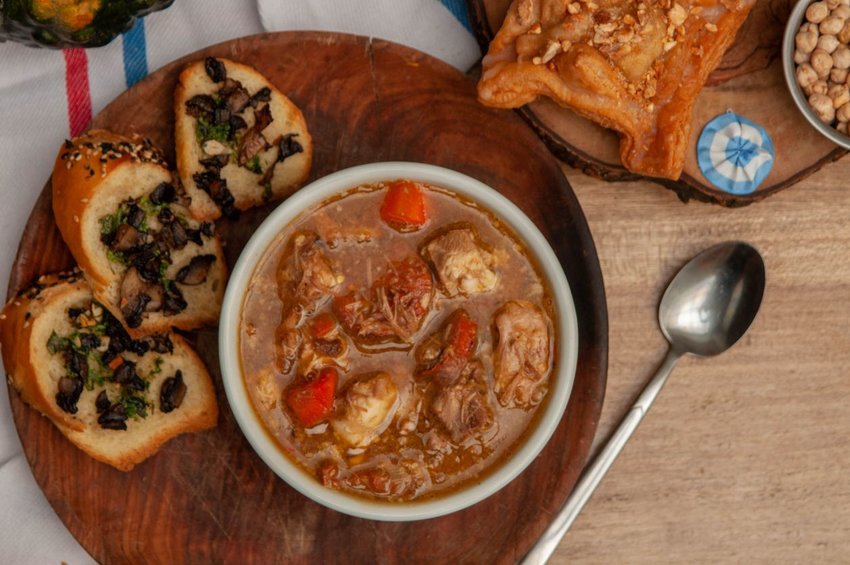A Journey Through the World of Locro: A Culinary Adventure
Related Articles
- Lontong Tahu: A Culinary Journey Through Indonesia’s Flavors
- A Journey Through The Flavors Of Sop Buntut: From Humble Beginnings To Culinary Masterpiece
- Tempe Mendoan: A Deep Dive Into Indonesian Street Food Delight
- A Journey Through Chili Relleno: From Humble Beginnings To Culinary Masterpiece
- A Journey Into The Heart Of Indonesia: Exploring The Delights Of Nasi Uduk
Introduction
Welcome to our in-depth look at A Journey Through the World of Locro: A Culinary Adventure
A Journey Through the World of Locro: A Culinary Adventure

Locro, a hearty and comforting stew, is a dish that transcends borders and cultures. From the Andes Mountains to the bustling streets of Latin America, this versatile dish has captivated palates for centuries. This article embarks on a culinary journey, exploring the rich history, diverse variations, and endless possibilities of locro.
A Glimpse into the Past: The Origins of Locro
Locro’s history is deeply entwined with the indigenous cultures of South America, particularly those of the Andean region. The word "locro" itself is believed to have originated from the Quechua language, spoken by the ancient Inca civilization. The dish’s origins can be traced back to pre-Columbian times, where indigenous communities utilized readily available ingredients like corn, beans, and squash to create a nourishing and satisfying meal.
Early forms of locro likely featured a simple combination of these ingredients, cooked in a communal pot over an open fire. As time progressed, the dish evolved, incorporating influences from different cultures and regions. The arrival of the Spanish in the 16th century brought new ingredients like pork and spices, further enriching the flavors and textures of locro.
A Tapestry of Flavors: The Many Faces of Locro
The beauty of locro lies in its adaptability. While the core ingredients remain consistent, the diverse regional variations offer a fascinating glimpse into the culinary landscape of Latin America.
1. Locro de Papa: The Andean Classic
This hearty stew, a staple in the Andean region, is a testament to the simplicity and richness of the dish. The key ingredient is potatoes, cooked until tender and creamy, creating a base for a symphony of flavors. Other common additions include:
- Corn: Adds a sweet and slightly nutty flavor.
- Beans: Provides protein and fiber, adding a hearty texture.
- Beef or Pork: Offers a savory depth and richness.
- Aji Panca: A Peruvian chili pepper, providing a smoky and spicy kick.
- Cumin: Adds a warm and earthy aroma.
- Oregano: Infuses the stew with a herbaceous freshness.

2. Locro de Quinua: A Nutritious Delight
This variation, popular in Ecuador and Peru, showcases the versatility of quinoa. Quinoa, a complete protein, adds a delightful nutty flavor and a fluffy texture to the stew. Other ingredients commonly found in locro de quinoa include:
- Green Beans: Offer a vibrant color and a crisp bite.
- Tomatoes: Add a tangy sweetness.
- Onions: Contribute a savory base flavor.
- Garlic: Adds a pungent and aromatic touch.
- Cilantro: Provides a refreshing finish.

3. Locro de Zapallo: A Creamy and Sweet Treat
This variation, often enjoyed in Argentina, features the sweet and savory flavors of pumpkin or squash. The pumpkin is cooked until soft and creamy, creating a velvety base for the stew. Other ingredients may include:
- Chorizo: A spicy sausage that adds a savory depth.
- Beef or Pork: Offers a rich and hearty flavor.
- Rice: Adds a fluffy texture and helps absorb the flavors.
- Paprika: Contributes a sweet and smoky flavor.
- Bay Leaves: Infuse the stew with a subtle aromatic complexity.
Mastering the Art of Locro: A Step-by-Step Guide
Creating a delicious locro requires a blend of patience and culinary finesse. Here is a comprehensive guide to crafting your own masterpiece:
1. The Foundation: Preparing the Base
- Sautéing: Start by sautéing onions, garlic, and any desired spices like cumin, oregano, or paprika. This step builds a flavorful base for the stew.
- Adding the Protein: Include your chosen protein, whether it be beef, pork, or chorizo. Cook until browned, creating a rich and savory flavor.
- Liquid Gold: Add broth or water to the pot, ensuring the ingredients are submerged. Allow the mixture to simmer, allowing the flavors to meld.
2. The Key Ingredients: Building the Flavor Profile
- Potatoes, Corn, and Beans: These three essential ingredients form the heart of most locro variations. Cook them until tender, ensuring a creamy and satisfying texture.
- Pumpkin or Squash: For locro de zapallo, add the pumpkin or squash to the stew. Cook until soft and creamy, allowing its sweetness to infuse the broth.
- Quinoa: For locro de quinoa, cook the quinoa separately until tender, then add it to the stew. Its fluffy texture and nutty flavor enhance the overall taste.
3. The Finishing Touches: Elevating the Flavor
- Seasoning: Adjust the seasoning to your liking, adding salt, pepper, and any desired spices.
- Finishing Touches: Incorporate herbs like cilantro or parsley for a refreshing touch.
- Garnishes: Add a dollop of sour cream or crema fresca for a tangy contrast.
4. The Art of Serving:
- Traditional Style: Serve locro hot, in a deep bowl.
- Creative Presentation: Explore different serving styles, like layering ingredients in a soup bowl or serving it with a side of rice or quinoa.
Culinary Tips for Perfect Locro
- Patience is Key: Allow the stew to simmer slowly, allowing the flavors to develop fully.
- Don’t Overcrowd the Pot: Give the ingredients space to cook evenly.
- Seasoning is Crucial: Adjust seasoning throughout the cooking process, as flavors can change over time.
- Experiment with Different Ingredients: Explore regional variations and add your own personal touch.
Locro Beyond the Basics: Exploring Variations
Locro’s versatility extends beyond traditional recipes. Explore these innovative ideas to create unique and exciting dishes:
1. Fusion Flavors: A Global Twist
- Asian Inspiration: Add ginger, soy sauce, and sesame oil for a savory and aromatic twist.
- Mediterranean Flair: Incorporate sun-dried tomatoes, olives, and feta cheese for a Mediterranean-inspired flavor profile.
- Indian Influence: Use garam masala, turmeric, and coconut milk for a warm and exotic experience.
2. Creative Combinations: Unleashing Your Inner Chef
- Locro Soup: Thin the stew with additional broth or water for a lighter and more soup-like consistency.
- Locro Bake: Layer the stew in a baking dish, top with cheese, and bake until golden brown for a comforting and cheesy meal.
- Locro Empanadas: Fill empanada dough with the stew for a handheld and delicious snack.
Locro: A Culinary Legacy for Generations
Locro, a dish that has stood the test of time, continues to captivate palates and inspire culinary creativity. From its humble origins to its diverse variations, this hearty stew remains a symbol of cultural heritage, culinary ingenuity, and the power of shared meals. As you explore the world of locro, embrace its adaptability, celebrate its flavors, and create your own culinary masterpieces. Enjoy the journey, and savor every delicious bite!
Closure
Thank you for reading! Stay with us for more insights on A Journey Through the World of Locro: A Culinary Adventure.
Make sure to follow us for more exciting news and reviews.
We’d love to hear your thoughts about A Journey Through the World of Locro: A Culinary Adventure—leave your comments below!
Stay informed with our next updates on A Journey Through the World of Locro: A Culinary Adventure and other exciting topics.






